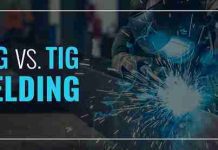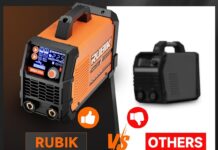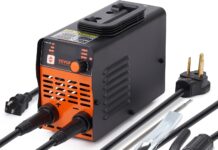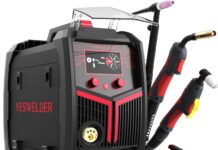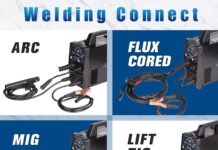Let us take you on a fascinating journey into the inner workings of an arc welder. Ever wondered how those sparks fly and metal pieces seamlessly fuse together? In this article, we unravel the mystery behind the remarkable process of arc welding. From electricity dancing with high temperatures to the orchestration of a welding rod, we will guide you through the key components and fundamental principles that come together to create this extraordinary welding technique. Get ready to be amazed by the intricate dance of energy and metal, as we uncover the secrets of how an arc welder works.
Overview
Arc welding is a versatile and widely used method of joining metal pieces together. It is a process that creates an electric arc between an electrode and the metal workpiece, causing the metals to melt and fuse together. This article will provide a comprehensive understanding of arc welding, including its basic principles, components of an arc welder, setting up the welder, the welding process itself, different types of arc welding, advantages and disadvantages, safety precautions, and common troubleshooting issues.
Definition of Arc Welding
Arc welding is a technique used to join metals by melting them together using a high-intensity electric arc. The electric arc is formed between an electrode and the workpiece, which melts both the electrode and the base material, creating a molten pool that solidifies to form a strong bond upon cooling. Arc welding can be performed on a wide range of metals, from steel and aluminum to stainless steel and cast iron.
Basic Principle of Arc Welding
The basic principle of arc welding involves the creation of an electric current between the electrode and the workpiece. The electrode, which is made of a consumable or non-consumable material, serves as the source of filler metal or as a thermal conductor. When the electric current passes through the electrode and the workpiece, a high-temperature arc is formed, which melts the base metal, allowing the electrode material to mix with the molten pool and create a weld joint.
Components of an Arc Welder
To perform arc welding, several essential components are required. Let’s take a closer look at each of these components.
Power Source
The power source is the heart of an arc welding setup. It provides the electrical energy needed to create and sustain the arc. Arc welders typically use either direct current (DC) or alternating current (AC) power sources. The type of power source chosen depends on the specific welding process and the type of metal being welded.
Electrode Holder
The electrode holder, sometimes referred to as a stinger or electrode clamp, is a device that holds the electrode securely during welding. It is designed to conduct electricity from the power source to the electrode. The holder also allows for easy electrode replacement and adjustment during the welding process.
Ground Clamp
The ground clamp is an important component that connects the workpiece to the electrical ground. It ensures a complete circuit for the electric current to flow through, allowing for proper welding. The ground clamp should be securely attached to the workpiece, providing a stable electrical connection.
Electrode
The electrode is a critical element in the arc welding process. It can be consumable or non-consumable, depending on the welding application. Consumable electrodes are made of materials that melt and deposit into the weld joint, while non-consumable electrodes are typically made of tungsten and do not melt. Electrodes come in different types and sizes to suit various welding requirements.
Welding Cable
The welding cable connects the power source to both the electrode holder and the ground clamp. It carries the electrical current from the power source to the welding setup, ensuring a proper and steady flow of power. Welding cables are designed to handle high currents and maintain a reliable connection.
Welding Helmet
A welding helmet is an essential safety gear to protect the welder’s face and eyes from the intense light, sparks, and UV radiation produced during arc welding. It features a unique darkened lens that automatically adjusts to the brightness level when an arc is struck. The helmet also provides a shield against any flying debris or metal particles.
Setting Up an Arc Welder
Before commencing any welding task, it is crucial to set up the arc welder correctly. Here are the steps to follow for a successful setup.
Selecting the Appropriate Power Source
The first step is to choose the right power source for the welding process. Consider the type of welding required, the metal being welded, and the recommended current type (DC or AC) for the specific welding application. Consult the welder’s manual or seek professional guidance to ensure the appropriate power source is selected.
Attaching the Electrode Holder
Next, securely attach the electrode holder to the power source. Ensure that all connections are tight and properly insulated to prevent any electrical hazards. It is essential to follow the manufacturer’s instructions to achieve a secure and reliable attachment.
Connecting the Ground Clamp
Connect the ground clamp to the workpiece securely. The ground clamp should be clamped onto a clean metal surface to ensure a good electrical connection. Any paint, rust, or dirt should be removed from the workpiece to establish an effective grounding.
Choosing the Appropriate Electrode
Select the appropriate electrode based on the material being welded, the welding position, and any specific requirements for the project. Different types of electrodes have specific characteristics and are suitable for specific welding applications. Refer to the electrode classification chart or consult a welding professional to help determine the right electrode for the job.
Connecting the Welding Cable
Connect the welding cable to both the electrode holder and the ground clamp. Make sure the connections are secure and free from any damage. Inspect the welding cable for any signs of wear or exposed wires and replace it if necessary. A faulty welding cable can lead to poor weld quality and safety risks.
Wearing the Welding Helmet
Put on a welding helmet to protect your face and eyes from the intense light and sparks generated during the arc welding process. Ensure that the helmet fits properly and comfortably, providing adequate protection and visibility. Check that the automatic darkening feature is functioning correctly.
The Arc Welding Process
Once the arc welder is set up correctly, it’s time to understand the arc welding process itself. Here’s a step-by-step guide to the process.
Generating an Electric Arc
To initiate the welding process, the electrode is brought into close proximity with the workpiece while maintaining a suitable arc length. The power source generates an electric current that flows through the electrode, creating a high-temperature electric arc. The arc emits intense heat and light, forming the basis for melting the metals.
Melting the Electrode
As the electric arc heats up, the electrode material starts to melt and form a molten pool. This molten metal acts as a consumable filler material or forms the base material for non-consumable electrode welding. The molten pool is crucial for welding various joint configurations and achieving the desired bond strength.
Forming the Weld Bead
With the electrode melted and the molten pool established, the welder moves the electrode along the joint, depositing the molten metal onto the workpiece. This creates a weld bead, which solidifies as it cools, fusing the base metal and the electrode material together. The weld bead provides the required strength and continuity across the joint.
Types of Arc Welding
Arc welding encompasses various techniques, each with its own advantages and applications. Let’s explore some of the common types of arc welding.
Shielded Metal Arc Welding (SMAW)
Shielded Metal Arc Welding, also known as stick welding, is one of the most widely used arc welding methods. It involves using a consumable electrode coated with a flux to shield the weld area from atmospheric contaminants. SMAW is versatile and can be used for welding thick materials, making it suitable for construction, maintenance, and repair work.
Gas Metal Arc Welding (GMAW)
Gas Metal Arc Welding, often referred to as MIG welding, utilizes a continuous wire electrode and a shielding gas to protect the welding area. GMAW is known for its high deposition rates and ease of use. It is commonly used in automotive, fabrication, and manufacturing industries, providing efficient and precise welding results.
Flux-Cored Arc Welding (FCAW)
Flux-Cored Arc Welding is similar to GMAW but uses a tubular electrode filled with flux instead of a solid wire. The flux provides a shielding gas when burned, creating a protective atmosphere around the weld area. FCAW is highly productive and suitable for outdoor applications, such as construction and shipbuilding, as it can operate in windy and dirty conditions.
Gas Tungsten Arc Welding (GTAW)
Gas Tungsten Arc Welding, also known as TIG welding, employs a non-consumable tungsten electrode and an inert gas, usually argon, to shield the weld area. GTAW produces high-quality, precise welds and is commonly used for thinner materials, stainless steel, aluminum, and critical applications that require superior weld aesthetics and strength.
Advantages of Arc Welding
Arc welding offers several advantages that make it a popular choice in various industries. Let’s explore some of these advantages.
Versatility
Arc welding can be used to weld a wide range of metals, including steel, aluminum, stainless steel, cast iron, and more. This versatility makes it suitable for diverse applications, from heavy construction and fabrication to intricate artistic work.
Ease of Use
Arc welding techniques are relatively easy to learn, making it accessible to both professionals and hobbyists. The equipment required for arc welding is commonly available, and with a basic understanding of the process and safety precautions, individuals can start welding with minimal training.
Cost-effectiveness
Arc welding is a cost-effective method of joining metals due to its widespread use and availability of equipment and consumables. The simplicity of the process also contributes to its cost-effectiveness as it requires fewer complex setups and additional materials.
Ability to Weld Various Materials
Arc welding can handle a wide range of materials, making it suitable for multiple industries. Whether it’s thick structural steel, thin sheet metal, or exotic metals, arc welding techniques can be adapted to accommodate different material specifications and joint configurations.
Disadvantages of Arc Welding
While arc welding has numerous advantages, it is important to consider some of its disadvantages as well. Let’s explore a few of these factors.
Low Welding Speed
Arc welding is generally slower compared to other welding methods, such as laser welding or electron beam welding. The relatively slower speed may be a limitation in mass production environments requiring high welding rates.
Limited Joint Thickness
Arc welding may have limitations in terms of joint thickness. While it can handle a wide range of material thicknesses, extremely thick joints may require multiple passes or specialized welding techniques to ensure proper penetration and bond strength.
Environmental Hazards
The arc welding process generates intense ultraviolet (UV) radiation, as well as fumes and gases from the base material and electrode coatings. Prolonged exposure to UV radiation can cause skin burns and eye damage, while the fumes and gases can be toxic if inhaled. Adequate ventilation and proper personal protective equipment are necessary to minimize these hazards.
Need for Skilled Operators
Although arc welding techniques are relatively easy to learn, achieving high-quality welds and ensuring optimal safety requires skilled operators. Understanding the specific welding process, selecting the right electrodes, controlling welding parameters, and practicing proper techniques necessitate training and experience.
Safety Precautions for Arc Welding
Safety is paramount when it comes to arc welding. Proper precautions must be taken to ensure the well-being of the welder and those in the surrounding area. Here are some essential safety measures to follow.
Proper Protective Gear
Wear appropriate personal protective equipment (PPE) when performing arc welding. This includes a welding helmet with a darkened lens, safety glasses, flame-resistant clothing, welding gloves, and steel-toed boots. The PPE should provide adequate protection against heat, sparks, UV radiation, and potential hazards.
Well-Ventilated Area
Ensure that the welding area is well-ventilated to minimize the accumulation of hazardous fumes and gases. When working indoors, use exhaust ventilation systems or position fans to direct the fumes away from the welder. Working outdoors or in open spaces provides natural ventilation, but additional measures may be required in enclosed areas.
Grounded Workpiece
Properly ground the workpiece to reduce the risk of electrical shock. The ground clamp should be securely connected to a clean metal surface, ensuring a direct and reliable electrical path to the workpiece. A well-grounded workpiece also provides stability during welding, preventing accidental movements that could compromise the weld quality.
Knowledge of Electrical Safety
Understand the basics of electrical safety to prevent electrical shocks and fires. Ensure that the welding equipment is properly grounded and the power source is correctly wired. Avoid welding near flammable materials or in areas with potential electrical hazards. Regularly inspect cables and connections for damage, and never touch any exposed electrical parts while the equipment is energized.
Fire Safety Precautions
Have suitable fire extinguishing equipment readily available in the welding area. Extinguishers specifically designed for Class D (combustible metals) fires should be used to tackle any fire caused by sparks or molten metal. Remove any flammable materials or cover them with fire-resistant materials to minimize the risk of accidental fires.
Common Issues and Troubleshooting
During arc welding, certain issues may arise that can affect the quality of the weld. Here are some common problems and possible troubleshooting steps to address them.
Arc Striking Issues
If you’re having trouble striking an arc, ensure that the electrode is free of contamination and properly sharpened. Check the welding cables and connections for any loose or damaged parts. Adjust the angle and distance between the electrode and the workpiece to create a stable arc. If problems persist, consult a welding professional for further guidance.
Weld Spatter
Weld spatter, the droplets of molten metal that land outside the desired weld area, can be minimized by adjusting the welding parameters and using anti-spatter spray or gel. Cleaning the workpiece before welding and using suitable shielding gases can also help reduce spatter. Regularly maintain and replace consumables to avoid excessive spatter buildup.
Porosity in the Weld
Porosity refers to the presence of gas pockets or voids within the weld, compromising its integrity. This issue can be caused by improper shielding gas, contaminated welding materials, or incorrect welding technique. Ensure the welding area is properly shielded, use clean electrodes, and maintain the correct arc length and travel speed to mitigate porosity.
Undercutting
Undercutting occurs when excessive heat causes the base metal to melt away, resulting in a groove along the weld joint. It can be caused by incorrect welding parameters, improper technique, or insufficient pre-weld preparation. Adjust the welding parameters as per the material thickness, maintain a steady travel speed, and properly clean and prepare the joint area to prevent undercutting.
Cracking of the Weld
Weld cracking occurs due to excessive stress, inadequate joint preparation, or poor welding technique. Proper joint design, pre-weld stress relief, and maintaining suitable welding parameters can help reduce the risk of cracking. Additionally, selecting the appropriate electrode type and properly controlling the heat input during welding can prevent cracking.
Conclusion
Arc welding is a versatile and widely used welding method that offers numerous advantages in joining metal materials. Its basic principle of creating an electric arc between an electrode and the workpiece allows for effective melting and fusion of metals. By setting up an arc welder correctly, selecting the appropriate welding process and electrode, and following safety precautions, skilled operators can achieve high-quality welds to meet various industry requirements.
Understanding the different types of arc welding and their applications provides welders with flexibility in addressing diverse welding needs. While arc welding has some limitations and challenges, proper training, experience, and adherence to safety practices can mitigate these issues.
In conclusion, arc welding is a valuable skill that combines technical expertise and creative craftsmanship. By embracing proper training and safety measures, welders can harness the power of arc welding to create strong, reliable, and aesthetically pleasing weld joints in a multitude of applications.



